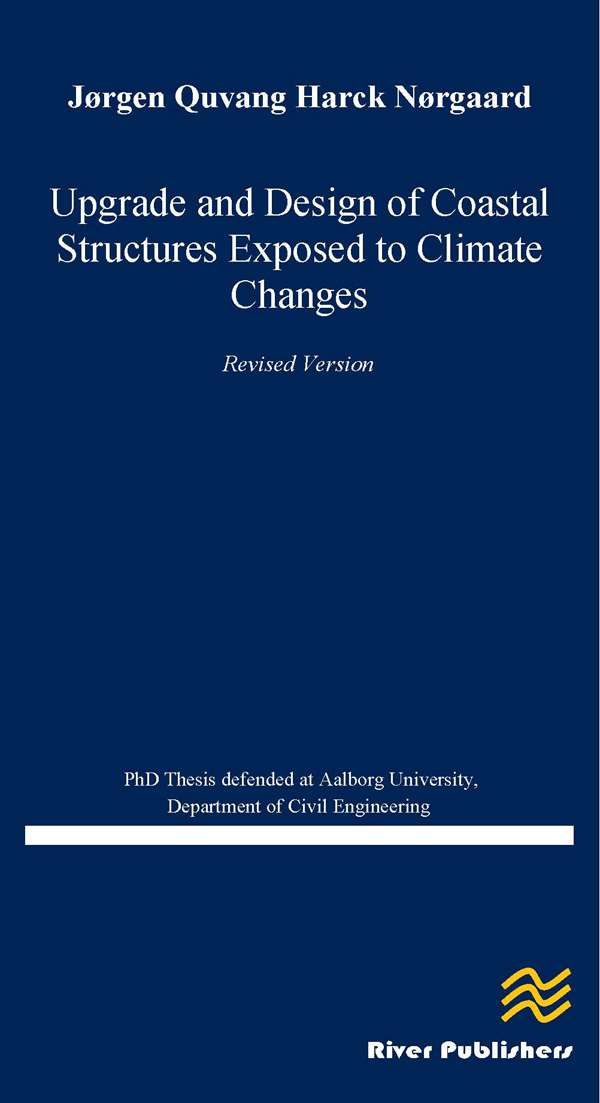River Publishers Series in
Upgrade and Design of Coastal Structures Exposed to Climate Changes
Author: Jørgen Quvang Harck Nørgaard, Department of Civil Engineering, The Faculty of Engineering and Science, Aalborg University, Aalborg, Denmark
This thesis "Upgrade and Design of Coastal Structures Exposed to Climate Changes" evaluates the
performance of existing types of structures when exposed to climate changes. This includes also the
potential of using cost‐sharing multipurpose structures for protection against the effects of future climate
changes.
The thesis consists of three parts. The first part evaluates the performance of existing design formulae for estimation of wave actions on structures, especially in shallow water since these structures are most vulnerable to the rising sea water levels caused by climate changes. Existing design formulae for estimation of wave loads and single overtopping wave volumes on rubble mound breakwater crown walls are considered too conservative in cases with shallow‐water wave conditions where highest waves are limited by depth. The formulae are thus modified to include the effects of non‐Rayleigh distributed wave heights. Additionally, an extension of existing formulae for estimation of wave overtopping flow parameters on sea dikes is performed to include the effects of oblique and short‐crested waves. The general outcome of the first part of the thesis are tools for design of selected types of coastal protection structures, which are extended to a wider range of wave conditions, and which can be used to more accurately estimate the influence from climate changes.
In the second part of the thesis, the extended and modified formulae are used in case studies to evaluate the influence from climate changes on a typical sea dike structure and typical rubble mound breakwaters positioned in deep and shallow waters. Additionally, two case examples are evaluated on the use of cost‐sharing multipurpose structures for coastal protection. The first case example evaluates the potential of using wave energy converters for coastal protection in Santander, Spain. The second case example evaluates the potential of using a barrier for protection against storm surges and for improvement of water exchange in the Limfjord, Denmark.
The third and last part summarizes and discusses the conclusions in the thesis. Moreover, it gives suggestions for future complementary work. The conclusions provide an overview of some of the most important topics in relation to design of coastal protection structures in deep and shallow water and in relation to evaluation of impact from climate changes. Additionally, the conclusion presents an evaluation of the use of new types of innovative multipurpose structures for coastal protection against future climate changes.
The thesis consists of three parts. The first part evaluates the performance of existing design formulae for estimation of wave actions on structures, especially in shallow water since these structures are most vulnerable to the rising sea water levels caused by climate changes. Existing design formulae for estimation of wave loads and single overtopping wave volumes on rubble mound breakwater crown walls are considered too conservative in cases with shallow‐water wave conditions where highest waves are limited by depth. The formulae are thus modified to include the effects of non‐Rayleigh distributed wave heights. Additionally, an extension of existing formulae for estimation of wave overtopping flow parameters on sea dikes is performed to include the effects of oblique and short‐crested waves. The general outcome of the first part of the thesis are tools for design of selected types of coastal protection structures, which are extended to a wider range of wave conditions, and which can be used to more accurately estimate the influence from climate changes.
In the second part of the thesis, the extended and modified formulae are used in case studies to evaluate the influence from climate changes on a typical sea dike structure and typical rubble mound breakwaters positioned in deep and shallow waters. Additionally, two case examples are evaluated on the use of cost‐sharing multipurpose structures for coastal protection. The first case example evaluates the potential of using wave energy converters for coastal protection in Santander, Spain. The second case example evaluates the potential of using a barrier for protection against storm surges and for improvement of water exchange in the Limfjord, Denmark.
The third and last part summarizes and discusses the conclusions in the thesis. Moreover, it gives suggestions for future complementary work. The conclusions provide an overview of some of the most important topics in relation to design of coastal protection structures in deep and shallow water and in relation to evaluation of impact from climate changes. Additionally, the conclusion presents an evaluation of the use of new types of innovative multipurpose structures for coastal protection against future climate changes.
